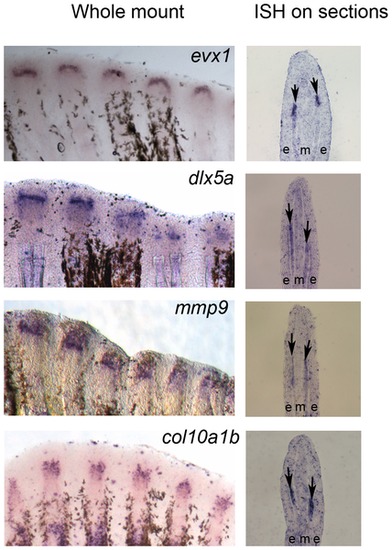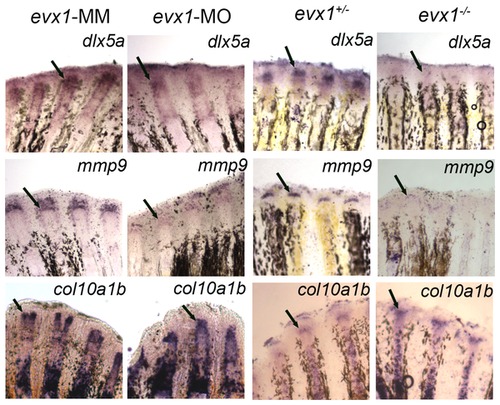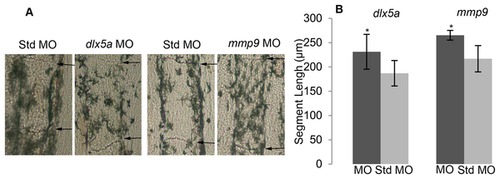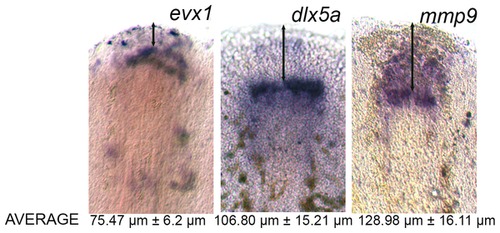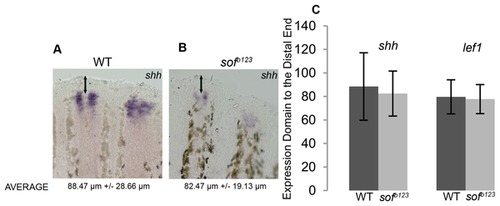- Title
-
Identification of an evx1-Dependent Joint-Formation Pathway during FIN Regeneration
- Authors
- Ton, Q.V., and Iovine, M.K.
- Source
- Full text @ PLoS One
|
Expression of joint genes in regenerating fins. (Left) Whole mount ISH shows evx1, dlx5a, mmp9, and col10a1b are expressed in 5 dpa wild type fins. (Right) ISH on wild-type 5 dpa cryosections reveal expression of joint genes in the lateral skeletal precursor cells. Arrows point to gene expression in the skeletal precursor compartment. (e) epithelium; (m) mesenchyme. EXPRESSION / LABELING:
|
|
dlx5a and mmp9 are genes downstream of evx1. (A) Whole mount ISH shows levels of dlx5a expression and mmp9 expression are reduced in the evx1-morpholino (evx1-MO) injected side compared with the evx1-mismatch (evx1-MM) injected side, while the level of col10a1b expression is unchanged. (B) Whole mount ISH on evx1-/- mutants displays similar results seen in the evx1-MO injected fins, except that a stronger reduction in dlx5a and mmp9 is observed. Arrows identify regions of the fin where staining is present and/or expected (i.e. in the cases where reduced evx1 influences expression levels). EXPRESSION / LABELING:
|
|
Morpholinos target all cellular compartments of the regenerating fin. Fluorescein-positive cells successfully took up the morpholino (1 day post electroporation). The two left panels reveal loss of fluorescein signal following in situ hybridization. The two right panels demonstrate that fluorescein-positive cells are observed in all cellular compartments in freshly harvested and cryosectioned fins. The basal layer of the epidermis (ble) is identified as a row of cuboidal cells between the epithelium (e) and the mesenchyme (m). The skeletal precursor cells (sp) are located adjacent to the ble. Morpholino uptake is observed in the outer epithelial layers, in the skeletal precursors, and in the medial mesenchyme. |
|
dlx5a and mmp9 are necessary for correct joint placement. (A) Segment length is increased following targeted gene knockdown of dlx5a and mmp9 compared with standard control (std) morpholino knockdown (negative control). (B) Segment length is increased in dlx5a-knockdown and mmp9-knockdown fins compared with standard control morpholino. Statistically different data sets (*) were determined by the student’s t-test where p<0.05. The p-value for the comparison of segment length for the dlx5a-treated fins was p = 0.0047. The p-value for the comparison of segment length for the mmp9-treated fins was p = 0.0018. Error bars represent the standard deviation. MO, morpholino. PHENOTYPE:
|
|
Expression domains of joint genes expressed during fin regeneration. The double arrow identifies the measured distance between the expression domains and the distal tip of the fin. The measurement was taken from the third ray of each fin and the average and standard deviation (±) were calculated. |

Confirmation of the predicted evx1-dependent joint pathway. Morpholino-mediated gene knockdown followed by whole mount ISH show that dlx5a-knockdown causes reduced mmp9 expression (A) but does not influence evx1 expression (B). mmp9-knockdown does not influence dlx5a expression (C) or evx1 expression (D). Arrows point to the in situ hybridization staining. EXPRESSION / LABELING:
|
|
Reduced growth rate of sof b123 mutants does not influence patterning of gene expression. (A) Whole mount ISH of shh on WT fins (A) and on sof b123 fins (B). (C) The distance of expression of shh and lef1 to the distal end of the fin is not influenced by the reduced growth rate of sof b123 since the distances of the expression domains for shh and lef1 are not statistically different by the student’s t-test (p>0.05). The p-value for comparison of the shh domain was p = 0.19. The p-value for the comparison of the lef1 domain was p = 0.30. Arrows identify the region of the fin that was measured, from the distal expression domain to the distal end of the fin. Error bars represent the standard deviation. EXPRESSION / LABELING:
|
|
Expression of joint genes in alf dty86. Whole mount ISH of evx1 shows that evx1 is expressed consistently in wild-type but irregularly in alf dty86 (i.e. “on” vs. “off”) Astericks were placed just proximal to the evx1-positive staining in alf dty86, which are present even though expression is weak. In contrast, dlx5a and mmp9 are expressed in all fin rays in both wild-type and alf dty86 fins. EXPRESSION / LABELING:
|
|
Knockdown of cx43 rescues evx1 expression in alf dty86. (A) Whole mount ISH of evx1 shows that evx1 is expressed in most fin rays in cx43-morpholino (MO) fins (on) but not in cx43-mismatch (MM) fins (off). Arrows identify evx1-positive signal. (B) evx1 expression is present in a much higher percentage of fin rays in alf dty86 following injection/electroporation of cx43-MO compared with either the cx43-MM control fins or the uninjected fin rays. Statistical significance (*) was determined by student’s t-test where p<0.05 show significant differences. The p-value for the comparison of cx43-MO and cx43-MM was p = 0.0015. The p-value for the comparison of cx43-MO and uninjected fin rays was p = 0.0036. The bars represent the standard deviation. EXPRESSION / LABELING:
|

